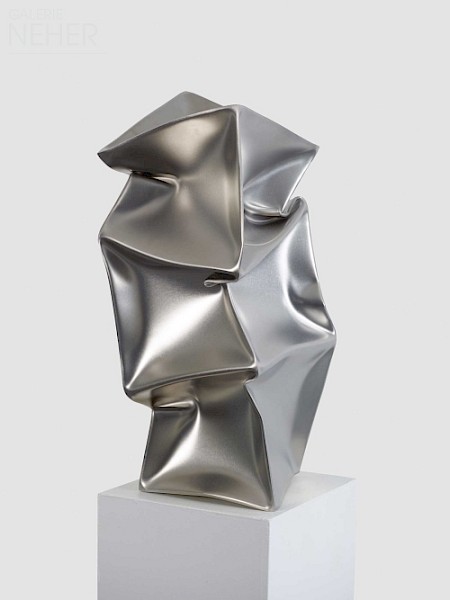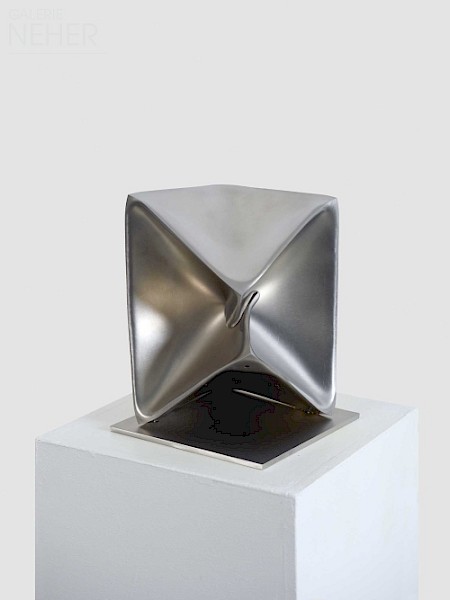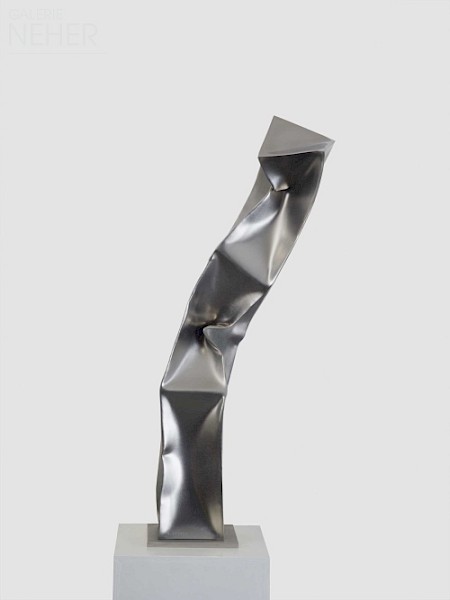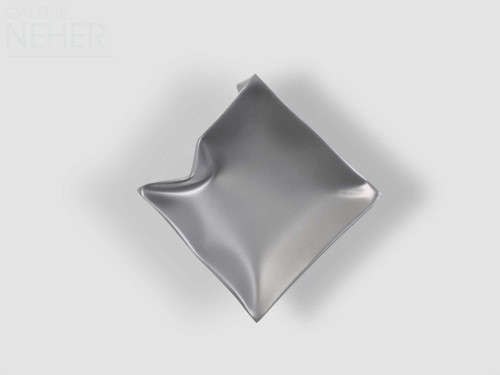Ewerdt Hilgemann
* 21 02 1938 | Witten
At the start of his artistic career, Ewerdt Hilgemann experimented with wall works of wood before turning to conceptual work with natural stone and allowed space for coincidence in his work. He has been producing the Implosionen (Implosions) since 1984, with which he has achieved international recognition. With the help of a vacuum pump, he empties his in some cases monumental, cubic, hollow bodies of stainless steel of air, thus subjecting the objects to a powerful, slow metamorphosis, which changes its form without impacting the gleaming perfection of the outer shell.
Works by Ewerdt Hilgemann
Vita Ewerdt Hilgemann
1938
Born in Witten.
1958/59
Studied at the University of Münster.
1959–61
Hilgemann studied at the Staatliche Werkkunstschule (now HBKsaar) and at Saarland University in Saarbrücken.
His teacher Oskar Holweck taught Zen philosophy, among other subjects.
1960s
At the beginning of his artistic career, Hilgemann produced white, square or round wall reliefs made from numerous small wooden rods, which joined with varying thicknesses and lengths to form visual patterns, in which light and shadow played a key role.
This resulted in a series of serial-minimalist installations of rods or tubes of steel or polyester for public spaces, bearing the title Space Structures.
1963
He worked in the artist settlement of Asterstein in Koblenz.
1964–67
The artist was distinguished with scholarships and prizes from the Aldegrever Gesellschaft, Münster, the Fritz Berg Stiftung, Hagen and the city of Gelsenkirchen.
1967–70
He lived in the artist settlement Halfmannshof in Gelsenkirchen.
1969
Together with his artist colleagues Helmut Bettenhausen, Günter Dohr, Rolf Glasmeier, Kuno Gonschior, Friedrich Gräsel, Franz Rudolf Knubel, Ferdinand Spindel and Günter Tollmann, Hilgemann founded the exhibition collective B1, named for the Bundestraße 1 (federal motorway) that passes through the Ruhr region.
1970
Resettlement to Gorinchem, Netherlands.
Beginning of the 1970s
Abstract-geometric objects now became more central to his creative work, based on the principle of the square and the cube.
1974–89
Member of the international workgroup for constructive art.
1975–84
Studio and stay in Carrara, Italy.
1977–98
Lecturer at the Academie van Beeldende Kunsten, Rotterdam.
early 1980s
Hilgemann quit working with the grid and made the cube the dominant form in his oeuvre. The artist now more frequently incorporated coincidence into the creation of his works.
He also produced works in stone during this period, in the course of which parts were damaged, cut off or destroyed.
1981/82
Tour of Europe.
1982
The man-sized Rolling Cube was created in Carrara, an initially perfect marble cube that was deliberately damaged by being thrown into a quarry.
1983
In a quarry in Carrara, Hilgemann had two marble spheres blasted into three and eight pieces with the help of gunpowder.
At the Oost-West Forum in Dordrecht in the Netherlands, he pushed a welded steel cube from the roof of a high-rise.
1984
Move to Amsterdam. He maintained a studio in Hardingxveld-Giessendamm near Gorinchem.
He stopped working with stone and from this point on occupied himself with the themes of volume and emptiness. The first Implosionen were produced through the suctioning out of air from geometric hollow bodies, which caused the forms to collapse. In these sculptures too, the cube remained a basic element upon which all works were based, and was also contained in the slender, vertical shafts many times over.
as of 1990
After previously also experimenting with other materials like, for example, aluminium or copper, he now concentrated exclusively on imploded stainless-steel sculptures.
1995
Exhibition in the Museum für Konkrete Kunst, Ingolstadt.
1996
Exhibitions in the Städtisches Museum (now Kunstmuseum Gelsenkirchen), in the Museum Waterland, Purmerend (NL) and the exhibition Panta Rei, Art Affairs, Amsterdam.
1998
Exhibition Sculpted by Air, Art Affairs, Amsterdam.
as of 1998
Regular stays in Los Angeles.
Numerous exhibitions in Europe and the USA.
2009
Three-month stay in New York.
Exhibition Amsterdam in New York, Art Affairs Project Space, New York.
2010
Hilgemann’s Imploded Column was erected in Beverly Hills.
2011
On the occasion of the reopening of the Messer Group GmbH in Bad Soden, a sculpture group by Ewerdt Hilgemann was erected on the Messer Square at the centre of the building.
Exhibition Ewerdt Hilgemann. Der Luftschmied in the Luftmuseum, Amberg, and in the Flottmann-Hallen, Herne.
2014
Park Avenue Project 2014 at the invitation of the Sculpture Committee of The Fund for Park Avenue of New York. Hilgemann erected seven monumental, site-specific sculptures along Park Avenue.
Implosion Event exhibition in the Kunsthalle Bremen. The benefactress Vera König endowed the Kunsthalle with the sculpture Imploded Cube from the same year. It was placed in front of the Kunsthalle.
2017
The stainless sculpture Imploded Pyramid from 2002 was erected in the Grugapark in Essen. It is today found on the lawn in the Lindenrund (Linden Circle).
2018
Hilgemann set up a studio in Kansas City.
The two-part work Dancers NY was erected in the city of Leawood in Kansas.
2020
Three of a Kind (No. 1) was erected on the campus of the American Jewish University in Los Angeles.
Exhibition with the title Ewerdt Hilgemann spanning 60 Years in the Kröller-Müller Museum, Otterlo.
Ewerdt Hilgemann lives and works in Amsterdam.
His works are presented in numerous YouTube videos.
Ewerdt Hilgemann first began imploding his geometric hollow bodies in 1984. This is effected by withdrawing the air from the inside of these cubic stainless steel objects using a vacuum pump (or sometimes also by emptying the water-filled hollow body) which are then crushed by the external air pressure. Yet the gleaming perfection of the external shell remains intact and generates in the viewer both optical and mental confusion: Although the objects are crumpled, they betray no signs of exterior impact - and yet it is obvious that an enormous force must have been exerted. The imploded work represents the random outcome of a physical process, and explores the issue of beauty and the uniqueness of geometrical imperfection. Commanding an imposing presence, the twisted objects are possessed of a striking aesthetic expressivity - in contrast to their original forms. Hilgemann's prototypes are made of stable, carefully-wrought stainless steel. Its self-generated transformation is no sudden event, but a gradual, yet powerful metamorphosis. Rather than a "happening", the process of implosion is a creative act which manifests itself visibly in the finished art work. Thus Hilgemann's completed implosions occasion us to reflect upon the nature of our existence. Internal transformations initiate external change. The expended energy remains palpable and turns a uniformly perfect serial product into an entirely new entity, imbued with its own history and the fascination of a personal aura.




